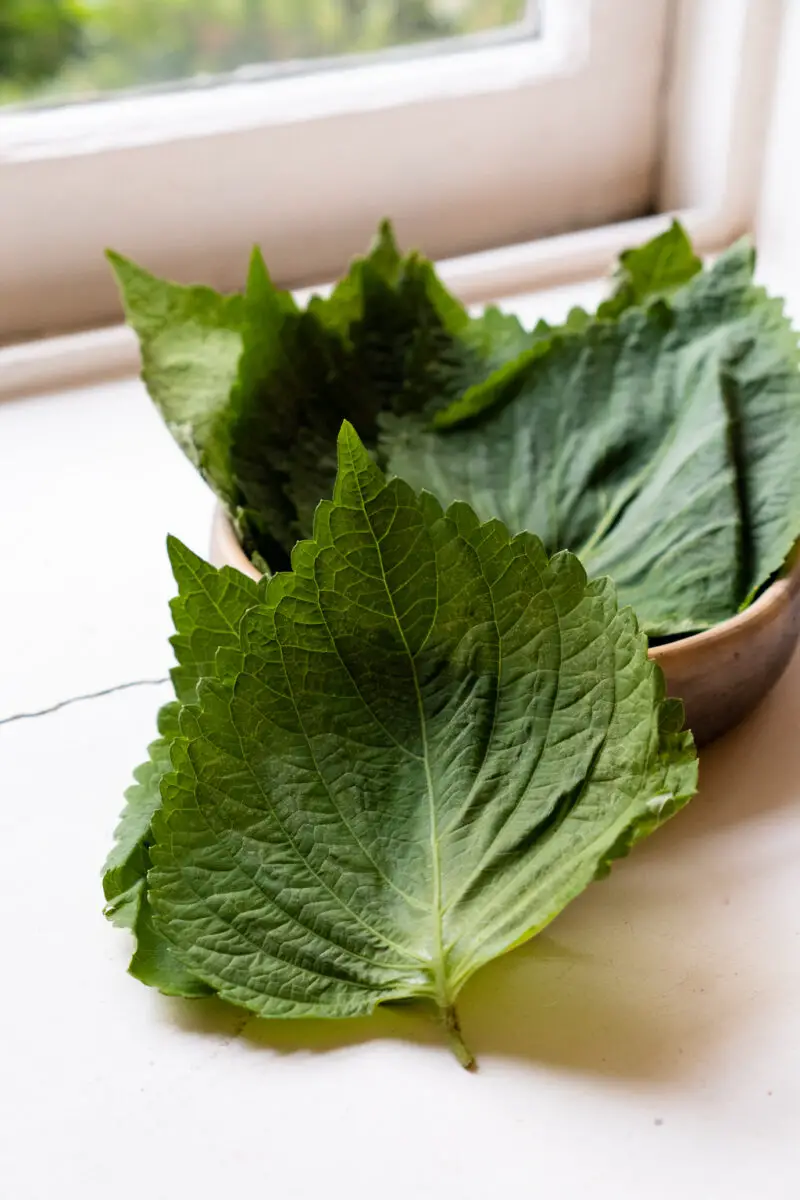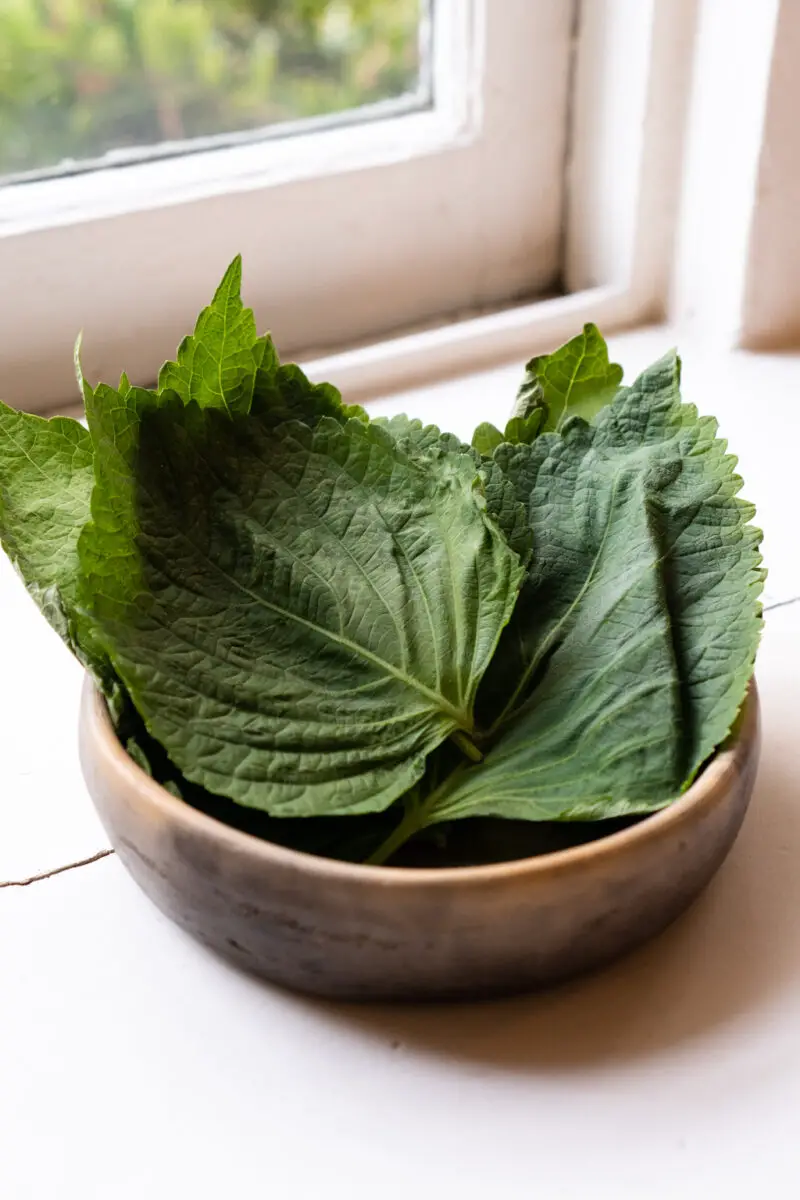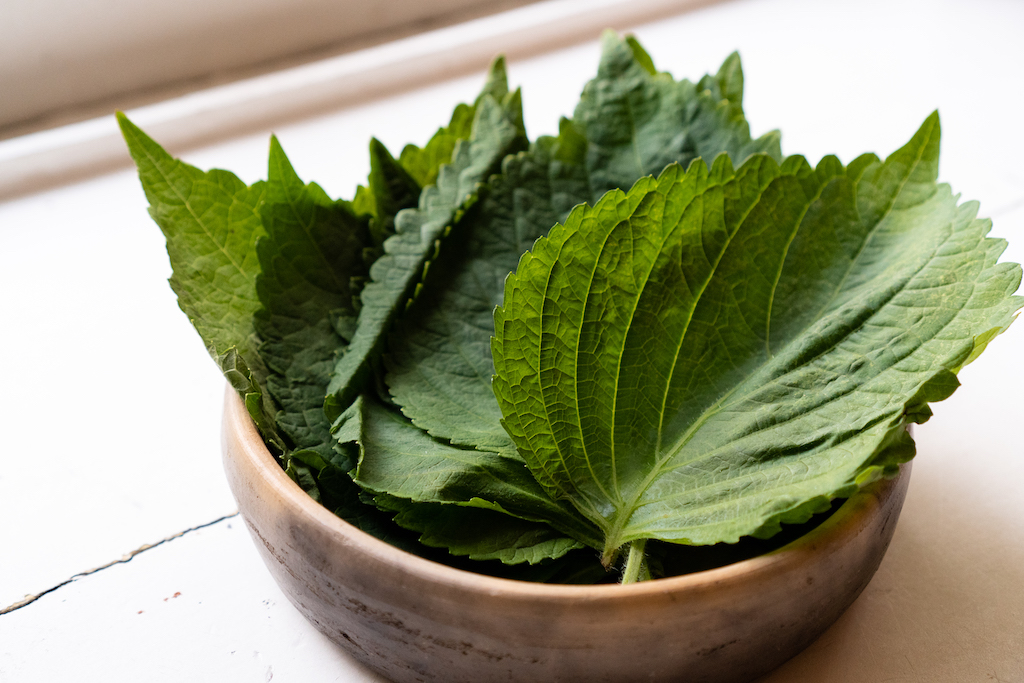This post may contain affiliate links. Please read my disclosure for details at the bottom of this page. As an Amazon Associate, I earn from qualifying purchases on this article about perilla leaves in Korean cuisine. I hope you enjoy learning about kkaennip, otherwise known as a perilla leaf!
Published 09/23/2021 Updated 01/04/2023
While uncommon in the United States, people in South Korea often eat a leafy green herb known as a ‘perilla leaf.’ These leaves are slightly bitter and spicy with a grassy note. In this post, we will discuss the perilla leaf. Specifically, we will learn about the leafy green, how people in Korea use it, and where to buy it.
What Is a Perilla Plant?
In scientific biological study, the term ‘Perilla’ refers to a particular genus of plant. It consists of one major type of Asiatic crop species–Perilla frutescens, as well as other wild species belonging to the mint family. Most famously, the Korean perilla plant (known as ‘deulkkae’ (들깨) in Korea) and the Japanese shiso are members of the perilla genus.
While the term ‘Perilla’ is used as a genus name in the scientific world, people also use it frequently as a colloquial term to describe and name particular varieties known within its genus. Most commonly, people use this term to describe a particular variety found, cultivated, and harvested on the Korean peninsula.
What Are Perilla Leaves? What Is a Korean Perilla Leaf?
The Korean ‘deulkkae’ (들깨) is a species of perilla in the mint family. It is an annual plant, meaning it completes its life cycle from germination to the production of seeds before dying in one growing season.
The plant is native to Southeast Asia and parts of India. People traditionally grew and harvested these plants as a crop in the Korean peninsula, southern China, Japan, and India, though the varieties may differ.
In the Korean language, ‘kkae’ (깨) refers to both the plant and seeds of sesame and perilla. While people refer to sesame as ‘chamkkae’ (참깨) meaning ‘true kkae’, they refer to perilla as ‘deulkkae’ (들깨) meaning ‘wild kkae.’
Finally, in the English language, we refer to the leaves of the plant as ‘perilla leaves.’ In Korean, people call the perilla leaves ‘kkaennip’ (깻잎), which literally translates into ‘leaves of kkae.’

How Do People In Korea Use the Perilla?
In South Korea, people commonly use different parts of the perilla plant to make popular dishes. Below, I list some of the most common and popular ways people use the plant in Korean cuisine.
Perilla Leaves (Kkaennip):
- Ssam: People often use fresh kkaennip (perilla leaves) as a ‘ssam’ vegetable when eating Korean barbecue (such as samgyeopsal). The Korean tern ‘ssam’ (쌈) means ‘wrapped’ in English. It refers to the method of wrapping barbecue meat and other side dishes in leafy greens.
- Kkaennip Kimchi: Another traditional method of using kkaennip is making it into a type of kimchi. This kimchi is known as ‘Kkaennip Kimchi’ (깻잎김치).
- Pickled Perilla Leaves: Often, people make a popular banchan (side dish) by pickling the perilla leaves in a soy-based sauce or soybean paste. This side dish is known as ‘kkaennip jangajji’ (깻잎 장아찌).
- Kimbap: Perilla leaves are often added into Korean seaweed and rice rolls known as ‘kimbap’ (김밥). If you are curious about the differences between kimbap and sushi, you can learn about the two here.
Perilla Seeds (Deulkkae):
- Perilla Oil: In Korea, people make perilla oil by toasting and pressing the seeds. This oil is known as ‘Deulgireum’ (들기름) in the Korean language. People use it for flavoring in sauces and dips.
- Perilla Powder: Often, people also toast and grind the perilla seeds into a powder known as ‘deulkkae-garu’ (들깨가루). They use this powder as a seasoning spice and condiment.

Kkaennip Frequently Asked Questions:
Now that we learned about kkaennip in Korean cuisine, I want to answer some questions you may have about this ingredient! If I do not answer your question, feel free to leave a comment in the section below or email me at [email protected].
What Do Perilla Leaves Taste Like?
As I stated above, these leaves taste slightly bitter and grassy. I actually find that these leaves taste slightly spicy.
Where Can I Buy This Ingredient?
While difficult to find in most western grocery stores, you can often find fresh perilla leaves in your typically Asian grocery store such as H-Mart.
How Do I Properly Store Perilla Leaves?
To store fresh perilla leaves, wrap them in damp paper towels and place them in a Ziplock bag. Then, place them in the refrigerator. You should consume them within 2-3 days. Otherwise, these leaves will go rancid.
What Is a Good Perilla Substitute?
If you cannot find Korean perilla leaves, you can use Japanese shiso instead. These smaller mintier leaves do not taste exactly the same, but they will work in recipes that require perilla.
We Hope You Enjoyed Learning About Korean Perilla Leaves!
In the end, I hope you enjoyed learning about the uses of perilla leaves in Korean cuisine. If so, let me know in the comment section!
If you would like to read more about cooking, you can find recipes as well as further Korean ingredient articles on my blog. I listed some of our favorite Carving A Journey recipes below! For reference, many recipes are influenced by my family’s blended Korean and Southern heritage.
Korean Ingredient Articles:
- Dangmyeon: Sweet Potato Glass Noodles
- Gochugaru: Korean Pepper Powder
- Korean Soy Sauce: What Should I Buy?
- Gluten-Free Gochujang Brands; And
- Gluten-free Doenjang Brands
Further Carving A Journey Korean Recipes:
- Korean Sweet Potato Latte (Goguma Latte)
- Tteokkochi (Korean Rice Cake Skewers)
- Jumeokbap (Handmade Korean Rice Balls); And
- Greek Momo Recipe (Korean Breakfast Trend)
If you have any questions or comments, you can also email me at [email protected].
And, finally, I would love to hear from you through our social media as well! You can follow me at @carvingajourney on Instagram, Twitter, Facebook, and Pinterest. I also started a vlog Youtube channel with my husband! Or, if you would like more articles like these, you can subscribe to the blog by joining the mailing list. Let me know if you try using kkaennip while cooking! Thank you so much for stopping by!
Carving A Journey is a participant in the Amazon Services LLC Associates Program, an affiliate advertising program designed to provide a means for sites to earn advertising fees by advertising and linking to Amazon.com. Although we may earn commissions for our endorsement, recommendation, testimonial, and/or link to any products or services from this website, these opinions are my own and I fully support these products.

